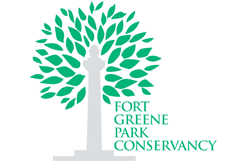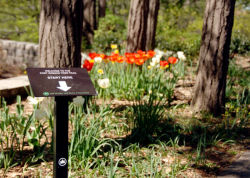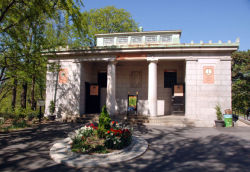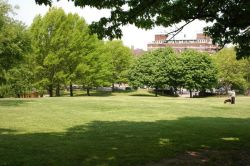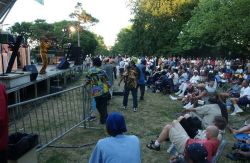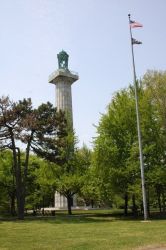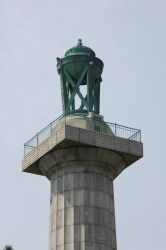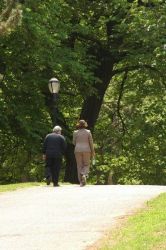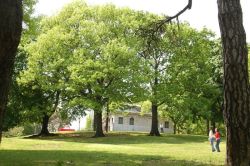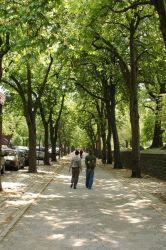Fort Greene Park
The Daily Plant : Thursday, June 1, 2006
1776 : When War Came To New York City
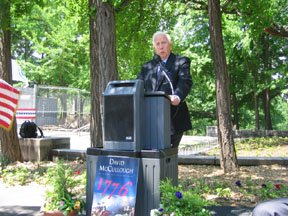
Photo by Phil Abramson
On May 18, 2006, Pulitzer Prize winning author David McCullough attended the opening of the new Visitors Center at Fort Greene Park. He discussed how research for his work, 1776, led him to visit Fort Greene Park because of the role that it played during that fateful year.
Indeed, eleven score and ten years ago, New York City was embroiled in war.
For modern day New Yorkers, it may seem difficult to imagine our City built up with fortifications. To us, the thought of an army landing and marching up Flatbush Avenue or Broadway seems unimaginable. But by the spring of 1776, for General George Washington, this was a harsh inevitability.
The main reason a foreign invasion seems out of the question today is that the United States military is the most powerful in the world. For example, the U.S. Navy currently has 282 deployable vessels, but in 1776 it had five. At the same time, it was Britain who held the title of being the world’s dominant superpower. By the summer of 1776, 300 British ships were sailing into New York’s harbor. For his part, Washington knew that however many ships Britain sent, it would far exceed the five that he had at his disposal. This meant that Washington was tasked with preparing his rebel army of less than 8,000 for a battle that, statistically speaking, was impossible to win.
Washington arrived in New York on April 13, 1776 and took up command at his headquarters at 1 Broadway, adjacent to the then 90-year-old Bowling Green Park. This helps demonstrate the congruity of parks planning and military planning that has resulted in so many of yesterday’s battlefields becoming today’s parks.
In both cases planners sought to find a location with a great view. From high up, a general can see the enemy coming and attack accordingly. Likewise, from high up, a park visitor can enjoy the natural and urban landscape. A general must strategize by determining what the enemy will do to achieve their goal, and then plan to prevent it. General Washington knew that a fort at Brooklyn Heights could protect Manhattan across the East River, so he built Fort Stirling at what is now the northern end of the Brooklyn Heights Promenade. He also realized that placing a fort there would make Brooklyn a target, so he built several forts further south in Brooklyn, including Fort Putnam, which would later be renamed Fort Greene and ultimately become the site of beautiful Fort Greene Park.
More recently, Parks acquired land on Governor’s Island where, by May, 1776, Washington also set up a cannon. Additionally, if you have never been to Brooklyn’s Valentino Pier, you should really go and see the view. You will immediately realize why Washington thought it so important to build Fort Defiance on that spot. With clear shots of the lower bay and the tip of Manhattan, that small Red Hook emplacement would prove crucial in August.
In addition to fortifications built at strategic locations that would later be determined suitable for parkland, the people of Manhattan prepared the streets for battle. Precursors of scenes of the French Revolution and Stalingrad, a British intelligence report uncovered by David McCullough explained, "every street facing North and East Rivers has wooden trunks made across ten feet thick filled with earth, in order to intercept any troops that may attempt a landing."
The spectre of the British invasion loomed all around the City. Washington told his men to keep their rifles with them in bed. Men at 1 Broadway kept watch of the horizon for the first signs of the fleet they knew was coming… but when?
Written by John Mattera
QUOTATION FOR THE DAY
"I am heartily rejoiced that my term is so near its close.
I will soon cease to be a servant and will become a sovereign."
James K. Polk
(1795 – 1849)
Check out your park's Vital Signs
Clean & Safe
Green & Resilient
Empowered & Engaged Users
Share your feedback or learn more about how this park is part of a
Vital Park System
Contacts
Director of Fort Greene Park: (718) 722-3218

